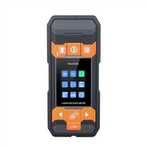Learn how to differentiate between the following anemometers
According to the principle, there are three main types of on-site anemometer measurement: differential pressure type, impeller type, and hot ball type.
The differential pressure method is a classic method of measuring flow velocity in fluid mechanics. It mainly relies on a pitot tube and a differential pressure meter to measure the dynamic pressure, and then calculates the flow velocity based on the Bernoulli equation. The advantages of this method are low detection limit and high sensitivity, but it requires high flow field uniformity. When measuring in the environment, it is easy to be inaccurate due to uneven flow field. Therefore, the pressure difference method is mainly used to measure wind speed in air ducts. .
The main principle of the hot ball type is that the probe sets a constant temperature. The air flows through the probe and takes away the heat. At this time, the probe will be heated to the set temperature. During this process, electrical signals will be collected by the instrument, and accordingly Convert to wind speed. The advantages of this method are high sensitivity, large range, and adaptability to environmental measurements. The disadvantage is that the platinum wire connecting the hot ball in the probe is relatively fragile. If you are not careful during use, the probe may be damaged and cannot be repaired. At present, the domestic hot ball anemometer is still an old-fashioned anemometer. The Air Conditioning Institute of the Institute of Construction Research has developed a more advanced alternative technology. The hot ball is replaced by a ceramic hot column, which is much stronger than the hot ball.
The impeller type mainly relies on the wind to rotate the impeller and produce electromagnetic signals for measurement. The advantage of this method is that the instrument is relatively durable and is often used for long-term measurements. The three-cup anemometer used in meteorological observations also uses the same principle. The disadvantage is that the sensitivity is slightly Difference.
Wind speed meters are measuring instruments for safety protection and environmental monitoring, and are mandatory calibration measuring instruments stipulated in my country's Measurement Law. Requirements for safe use of anemometers:
1. During use, if the anemometer emits an unusual smell, sound or smoke, or if liquid flows into the anemometer, please turn off the power immediately and take out the battery. Otherwise, there will be a risk of electric shock, fire and damage to the anemometer.
2. Do not expose the probe and anemometer body to rain. Otherwise, there may be a risk of electric shock, fire and personal injury.
3. Do not touch the sensor part inside the probe.
4. When the anemometer is not used for a long time, please remove the internal battery. Otherwise, the battery may leak, causing damage to the anemometer.
5. Do not place the anemometer in a place with high temperature, high humidity, dust, or direct sunlight. Otherwise, it will cause damage to internal components or deterioration of anemometer performance.
6. Do not use volatile liquids to wipe the anemometer. Otherwise, the anemometer housing may be deformed and discolored. If there are stains on the surface of the anemometer, you can wipe it with soft fabric and neutral detergent.
7. Do not drop or put heavy pressure on the anemometer. Otherwise, it will cause the anemometer to malfunction or be damaged.
8. Do not touch the sensor part of the probe when the anemometer is powered. Otherwise, the measurement results will be affected or the internal circuit of the anemometer will be damaged.






